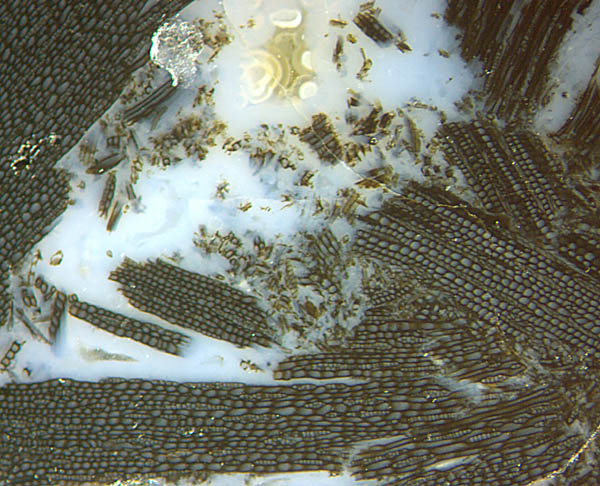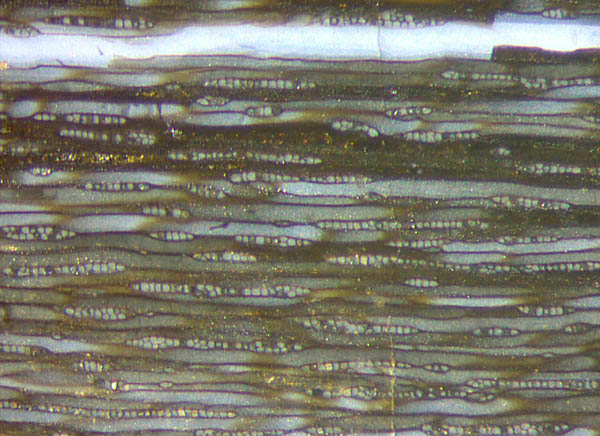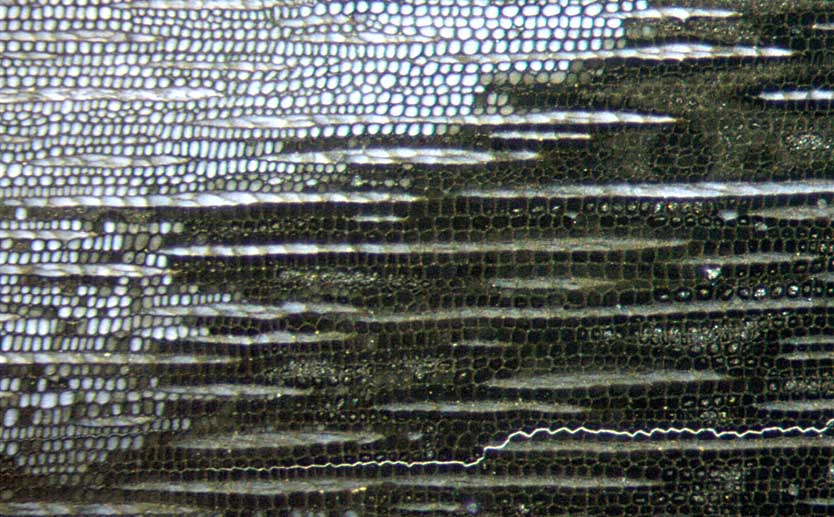Silicified wood mimicking charcoal

Permian petrified wood characterized
as "black and fragile before silicification" as in Fig.1 has been
mistaken repeatedly for fossil charcoal. Such mistake has been
rejected by means of this very sample [1].
Fig.1:
Coniferous-type wood, degraded and fragmented in water, then silicified
together with the water. Picture width 4mm. (Unrelated detail: pits from dissolved calcite above left.)
Whole
tree trunks allegedly turning into charcoal was thought to be feasible
when some catastrophic event piled trees into a big heap which finally
burned like a charcoal kiln [2]. One can do without such absurd
constructs of mind
since there is no charcoal involved here but black wood only.
The
black aspect of this wood must be due to other causes than the black
aspect
of charcoal is. The wood in Fig.1 could be black because the cell walls were coated with a black microbial layer. Black
microbial
layers are known from the Rhynie chert where they give an
illusion of sclerenchyma with thick cell walls.
A
larger contribution to the black aspect comes from an enigmatic stain
in the wood tracheids. This stain may vary along the tracheid between
light brownish and black, and it may fill the
cell partially or completely, as seen in Fig.2. There, the fracture of
the softened wood caused a black tracheid to break. Its broken ends are
distinctly visible in Fig.2 above right.

Fig.2: Silicified wood, lengthwise cut tracheids
with various
fills: light, variable, black; cross-cut ray cells mostly
light-coloured. Width 2mm.
Dark fills are also seen in some of the ray cells in Fig.2. Randomly
distributed stained tracheids, cut lengthwise in Fig.2, are seen
cross-cut in Fig.3 below left.
Conspicuously,
the dark fills tend to arrange themselves in radial rows which may fuse
laterally into dark areas. (This is also known from Carboniferous wood,
see Fossil
Wood News 21.)
As a peculiar fact, the cell walls, usually black
in this sample, are faintly seen as a gray structure in the black areas
in Fig.3.
Also conspicuous are the
rays, which had remained bright among the black wood.

Fig.3 (right): Silicified wood, cross-cut tracheids with various
fills: light, variable, black; cross-cut rays
light-coloured. Width 2.8mm, same scale as Fig.2.
A rare phenomenon is uncommonly clearly seen
here: The white line in Fig.3 below is an "easy crack path". Apparently
the adhesion between the cells had been degraded owing to
prolonged submersion so that
the crack did not have to break cell walls but took
the easy path between the cells while propagating
through the tissue.
Finally it appears that the charcoal aspect of this sample vanishes
with careful inspection, as already stated in [1]. Very probably the same applies to several other
cases of black silicified wood offered as fossil charcoal [2-4]. None
of the observed features fits
to silicified charcoal. (For comparison with fossil charcoal see [5],
for example.)
The cause of the black stain remains uncertain
here. From the variability of the stain along some tracheids in Fig.2 one
may conclude that possibly microbes had been involved
that were able to
blacken cell walls and spaces.
Sample W/55, found in 1992 during the preparation of the golf course
at Wilmsdorf, Doehlen Basin near Dresden, stored in the own collection.
Fig.1,3: W/55.2, Fig.2: W/55.3.
H.-J.
Weiss 2019
[1] H.-J.
Weiss: Fossil Wood News 9
[2]
R.
Noll, D. Uhl, S. Lausberg : Brandstrukturen an
Kieselhölzern der Donnersberg Formation.
Veröff. Mus. Naturkunde Chemnitz 26
(2003), 63-72.
[3] R.
Rössler : Der versteinerte Wald von Chemnitz. Museum f.
Naturkunde Chemnitz, 2001, 179.
[4] R.
Noll, V. Wilde : Conifers from the „Uplands“ –
Petrified wood from Central Germany,
in: U. Dernbach, W.D. Tidwell :
Secrets of Petrified Plants, D'ORO Publ., 2002, 88-103
[5]
A. Jasper, D. Uhl et al.: Evidence of wildfires
in the Late Permian …, Current
Science 110 No3 Feb.2016, 419-423.
|

|
 35 35 |

 35
35



 35
35